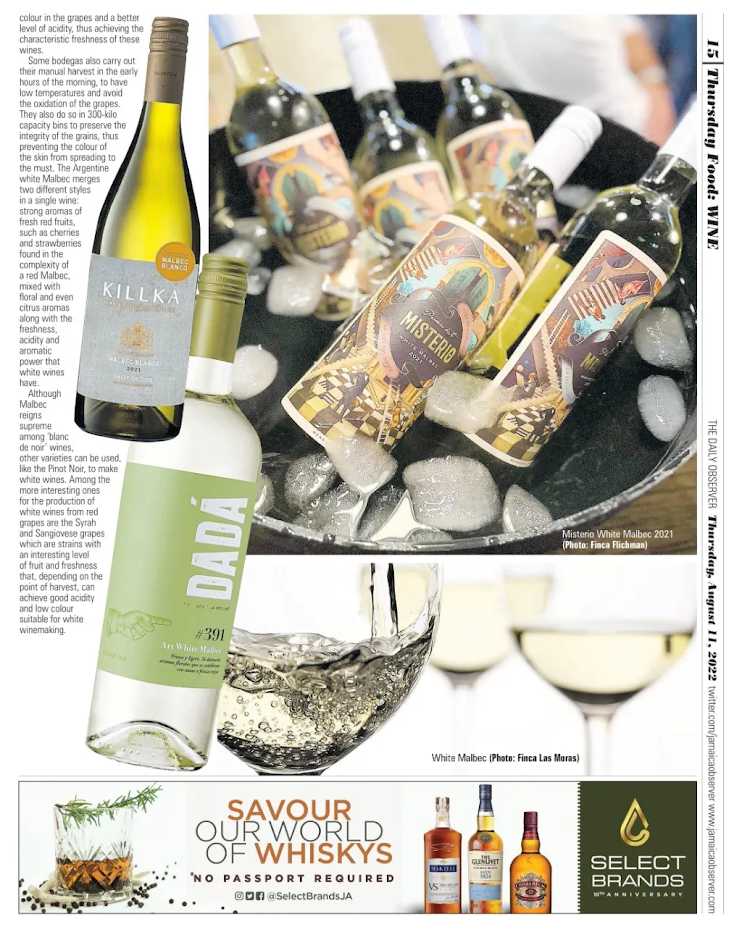ARGENTINA’S TRENDY WHITE MALBEC WINES: VERSATILE RED MALBEC BIRTHS ‘NEW’ WHITE SENSATION
The extreme versatility of the Malbec is evident in the way it has been able to adapt to the different terroirs of Argentina’s wine producing areas. The country’s world-renowned, emblematic red variety can be used for making rich young red wines, aging varietals, deliciously sweet specimens or even delicate rosé wines. It is also possible to produce fortified wines as well as sophisticated sparkling wines, which are all 100% Malbec, so the steady emergence of this red grape's most recent evolution as a white wine has been met with much excitement across the global wine regions. White Malbec is a wine made using a technique similar to that used to produce white wines, but from a red grape.
This ‘new’ style of wine, quite naturally, has a peculiarity whereby its aromatic palette gives the organoleptic characteristics of red wines but also white wines are intermingled. When in the mouth, it offers both a rich and present acidity, characteristic of sharp whites, but with a weight and and aromatic texture that brings them closer to the realm of reds. An exciting contrast that has endeared this newest variety to the many bodegas that have pursued production of the trendy new taste. Though it first made its entry into the market rather quietly some 10 years ago, the last 3 years has seen its production and sales improve steadily in the market. With red grapes such as Malbec, different white wines can be made.
White Malbec wine has aromas of red fruits but also of white flowers and even citrus notes. The secret to making a red Malbec lies in the characteristic color of the skins of the grapes. On the other hand, the pulp, from which the juice is extracted, offers the same coloration as in the case of a white variety. So, the key to obtaining a Malbec white wine is to press the grains subtly and very quickly, to prevent the must (also known as ‘young wine’) from coming into contact with the skins, contrary to what is done when you want to obtain a red wine with intense colours and depth. This is a task that requires great precision from the winemaker as just a few minutes are enough for the skins to stain the must, turning a potential white wine into a rosé wine.
Achieving the right colour is the most difficult aspect of the winemaking process as the pressure or contact with the skins must be minimal. In this very delicate process Malbec white wine is conceived from the vineyard. The oenologist in the winery ensures good quality grapes are produced in the vineyard as a key factor to guarantee good levels of acidity. For any quality white grape, health, the point of harvest and the quality of the harvest are the fundamental variables that contribute to the success of any white wine which will be produced. This means bodegas have to think about the production of a white Malbec wine from the moment of pruning the vines. Additionally, higher yields can lead to less colour in the grapes and a better level of acidity, thus achieving the characteristic freshness of these wines.
Some bodegas also carry out their manual harvest in the early hours of the morning, to have low temperatures and avoid the oxidation of the grapes. They also do so in 300-kilo capacity bins to preserve the integrity of the grains, thus preventing the color of the skin from spreading to the must. The Argentine white Malbec merges two different styles in a single wine: strong aromas of fresh red fruits, such as cherries and strawberries found in the complexity of a red Malbec, mixed with floral and even citrus aromas along with the freshness, acidity and aromatic power that white wines have.
Although Malbec reigns supreme among ‘blanc de noir’ wines, other varieties can be used, like the Pinot Noir, to make white wines. Among the more interesting ones for the production of white wines from red grapes are the Syrah and Sangiovese grapes which are strains with an interesting level of fruit and freshness that, depending on the point of harvest, can achieve good acidity and low color suitable for white wine making.
CREDITS:
PUBLISHED IN THE DAILY OBSERVER - THURSDAY AUGUST 11, 2022
ANDRE' WAYNE REID, A JAMAICAN IN ARGENTINA
NOVIA McDONALD-WHYTE, SENIOR ASSOCIATE EDITOR, LIFESTYLE & SOCIAL CONTENT
RORIE ATKINSON, ART DIRECTOR













Comments
Post a Comment